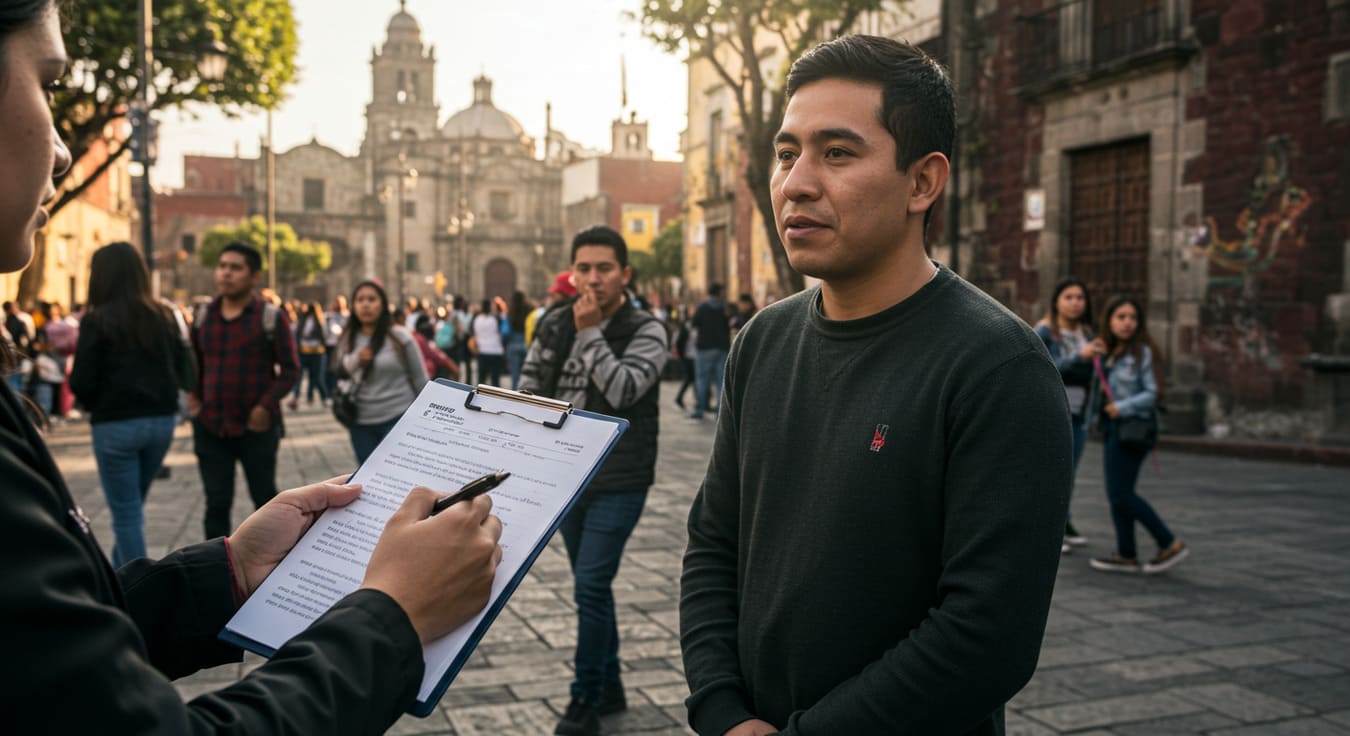Quantitative Research in Mexico

Mexico isn’t one market. It’s at least five distinct markets pretending to be a single country.
Quantitative research in Mexico is a whole new game with rules that might surprise you… But master these rules, and you’ll unlock opportunities that most businesses will never see.
Table of Contents
✅ Listen to this PODCAST EPISODE here:
The Real Mexico for Market Research
Forget the stereotypes. Mexico is a 130 million consumers and manufacturing powerhouse – and the gateway to Latin America that savvy businesses are leveraging while others remain clueless.
The raw truth? Most quantitative research in Mexico fails spectacularly. Why? They treated Mexico like a monolith. Big mistake.
When we conducted quantitative research in Mexico for a multinational beverage company, we discovered that regional preferences didn’t just vary slightly – they contradicted each other. Northern Mexicans rejected the very product formulation that Mexico City consumers adored. Our client’s competitors had missed this entirely, launching one-size-fits-all products that bombed half the country.
The Brutal Truth About Research Challenges in Mexico
Do you want success in Mexico? First, accept these hard realities that most researchers won’t admit:
The Digital Divide Is Wider Than Your Data Shows
Here’s a tough reality: Online-only quantitative research in Mexico is fundamentally broken.
Yes, Mexico has 76% internet penetration on paper. Impressive, right? Dig deeper. Rural connectivity remains spotty. Lower-income consumers often have limited data plans that make survey completion difficult. And the digitally excluded population isn’t random – it systematically skews your sample in ways that weighting can’t fix.
We tackled this head-on for a CPG client targeting mass-market consumers. Their previous online-only approach missed nearly 40% of their actual customer base. The mixed-methodology approach combining digital surveys with in-person interviews revealed fundamentally different usage patterns among the digitally underrepresented – insights that completely transformed their packaging strategy.
The tough lesson: If your quantitative research in Mexico is digital-only, you’re probably building strategies on a severely distorted foundation.
The Hidden Advantages Most Companies Miss

While most businesses struggle with basic execution, sophisticated companies are leveraging unique aspects of the Mexican market to gain decisive advantages:
Mexico’s Perfect Testing Ground Advantage
Mexico offers the perfect test market for Latin America – if you know how to use it right.
Mexico combines elements of traditional and modernizing consumer cultures within a manageable geographic area. This makes it an unparalleled laboratory for testing concepts before wider Latin American rollouts.
A global food manufacturer I’ve worked with for decades uses Mexico as their innovation proving ground. They test 15-20 concepts annually through targeted quantitative research in Mexico, knowing that success here translates remarkably well across the region. This approach has increased their new product success rate from 26% to 72% while reducing regional launch costs by millions.
The Bilingual Data Goldmine
Mexico’s proximity to the U.S. has created a unique research opportunity most companies completely overlook: access to genuinely bilingual and bicultural consumers.
These consumers don’t just speak two languages – they navigate two cultural worlds effortlessly. For companies looking to bridge North and Latin American markets, this segment provides invaluable perspective that can’t be found elsewhere.
Uno retail client leveraged this through specialized quantitative research in Mexico targeting bicultural consumers in northern border regions. The insights completely transformed their cross-border marketing approach, revealing subtle linguistic and cultural factors undermining their U.S. Hispanic market penetration. Sales increased 43% within six months.
The strategic edge: Well-designed quantitative research in Mexico can simultaneously inform U.S. Hispanic and broader Latin American strategies.
Industry Battlegrounds: Where Quantitative Research in Mexico Is Changing the Game

The Retail Revolution Nobody Saw Coming
Mexican shopping behavior operates on entirely different principles. Our retail clients discover this through specialized quantitative research in Mexico that maps the complete shopping journey, not just isolated purchase moments.
The breakthrough insight from recent quantitative research in Mexico: shopping is fundamentally social here. While U.S. consumers optimize for speed and convenience, Mexican consumers often view shopping as family entertainment and relationship building. Retailers who design experiences around this reality outperform competitors by margins that seem impossible – we’ve documented sales per square foot up to 34% higher than identical formats that miss this cultural element.
One retail giant completely reconfigured their store layouts based on our quantitative research in Mexico, creating family-friendly zones and community spaces. Their same-store sales growth outpaced competitors by 28% in the following year.
The Financial Services Opportunity Most Banks Miss
Effective quantitative research in Mexico uncovers the reality behind misleading statistics.
The banking statistics in Mexico can be misleading. Yes, approximately 40% of Mexicans remain unbanked (or underbanked). However, that surface-level data hides a more complex reality than the one revealed by sophisticated quantitative research in Mexico.
Traditional banking penetration might be limited, but financial sophistication runs deep in unexpected segments. Our financial services clients have discovered through targeted quantitative research in Mexico that even consumers without formal banking relationships often manage complex financial strategies across informal systems.
Healthcare: The Cultural Blindspots Costing Millions
If there’s one sector where cultural misunderstanding can be catastrophic, it’s healthcare. Yet most healthcare providers and pharmaceutical companies continue conducting quantitative research in Mexico using methodologies transplanted directly from U.S. or European markets.
The differences are more profound than most realize. Through specialized healthcare research, we’ve documented how Mexican patients navigate multiple parallel healthcare systems simultaneously – consulting public physicians, private doctors, and traditional healers for the same condition.
One pharmaceutical client was baffled by underperforming patient education materials until our quantitative research in Mexico revealed that their materials addressed only the patient, ignoring the family influencers who often make or break treatment adherence. Their redesigned approach, which explicitly incorporated family support roles identified through our research, improved adherence rates by 47%.
The Execution Playbook: Getting Quantitative Research in Mexico Right
Regional Stratification Is Non-Negotiable
Too many companies make devastating strategic errors based on national averages that concealed dramatic regional variations. The north, central region, Mexico City metro area, western states, and the south often function as distinct consumer cultures with different preferences, purchase drivers, and brand perceptions.
For one technology client, the regionally stratified quantitative research in Mexico revealed that their messaging was significantly underperforming in northern states despite strong national averages. Further analysis showed northern consumers found their creative approach too indirect and preferred more straightforward claims. The regionally tailored campaign they developed based on these insights outperformed their previous national approach by 52%.
The Mixed-Method Mandate
Online-only research is easier and cheaper. It’s also inadequate for most serious quantitative research in Mexico.
The digital divide remains significant enough that online-only methodologies systematically exclude important consumer segments. The most effective quantitative research in Mexico combines methodologies to ensure representativeness:
- Online surveys for urban, middle and upper socioeconomic segments
- Mobile-optimized approaches for younger, lower-middle segments
- Tablet-assisted in-person interviews for rural and lower socioeconomic groups
Cultural Adjustment Isn’t Optional
Mexican respondents typically demonstrate more positive responses than North American or European consumers. This isn’t wrong – it’s culturally appropriate. However, it requires analytical adjustment to avoid misinterpretation.
Techniques we apply in quantitative research in Mexico include:
- Indexed scores relative to category norms within Mexico
- Derived importance analyses that rely less on stated importance
- Advanced statistical techniques to identify response pattern effects
- Calibrated scales adjusted for Mexican response tendencies
The Emerging Middle Class: Mexico’s Most Misunderstood Research Opportunity

Mexico’s middle class is not a miniature version of the American middle class that happens to speak Spanish. It’s a unique consumer segment with distinct values, behaviors, and aspirations that most foreign companies misunderstand.
The most egregious mistake? Treating Mexico’s middle class as a monolithic segment. Our research consistently shows at least four distinct sub-segments with dramatically different consumption patterns—distinctions that become visible only through specialized quantitative research in Mexico.
The Digital Transformation
Mexico’s middle class isn’t following the same digital adoption patterns seen in other markets, a reality that creates challenges and opportunities for businesses that understand it.
Unlike the gradual digital evolution in many developed markets, Mexico’s middle class has leapfrogged directly to mobile-first and social commerce in ways that traditional quantitative research often fails to capture.
The Aspiration-Reality Gap Traditional Research Misses
Perhaps the most fascinating dynamic revealed through sophisticated quantitative research in Mexico is what I call the “aspiration-reality gap”—a tension between middle-class consumers’ aspirations and their economic realities that creates unique consumption patterns.
Standard quantitative research approaches typically measure either stated preferences (which skew aspirational) or actual behaviors (which reflect constraints)—missing the crucial interaction between them that shapes purchase decisions.
Para financial services provider, our specialized research uncovered that while middle-class Mexican consumers expressed strong interest in premium investment products (similar to affluent segments), their actual financial behaviors were driven by family safety nets and emergency preparation. This insight led to a hybrid product approach that outperformed traditional offerings by 35%.
Geographic Variations That Determine Success or Failure
Effective quantitative research in Mexico must capture these geographic variations with samples large enough to analyze emerging middle-class concentrations, not just traditional urban centers.
Our quantitative research in Mexico has documented how cities like Querétaro, Mérida, and Aguascalientes now have middle-class concentrations exceeding 55% of their populations, with distinctive consumption patterns that differ significantly from traditional urban centers.
The Value-Luxury Paradox Traditional Methods Miss
Standard research approaches typically classify consumers along a value-to-premium continuum, missing this category-specific variation that defines Mexican middle-class consumption.
Each of these insights required specialized research approaches that went beyond traditional methodologies to capture the unique dynamics of Mexico’s most promising consumer segment. Companies that rely on conventional frameworks aren’t just missing nuances—they’re missing the fundamental realities that determine market success.
The Future of Quantitative Research in Mexico

The research landscape in Mexico is evolving rapidly. Companies that adapt to these changes will gain significant competitive advantages:
Digital Transformation With Cultural Context
Mexico’s digital adoption is accelerating, but not always in ways that mirror other markets. Effective quantitative research in Mexico increasingly leverages digital methodologies while accounting for uniquely Mexican digital behaviors.
For example, social media is outsized in purchase decisions compared to many developed markets. Our quantitative research in Mexico consistently shows that social influence factors drive 30-45% more purchase behavior than comparable U.S. segments.
Smart companies are building this understanding into their research approaches, using specialized social listening techniques alongside traditional quantitative research in Mexico to capture a more complete consumer picture.
The Rise of Behavioral Data Integration
The most sophisticated clients are now combining survey-based quantitative research in Mexico with behavioral data sources to overcome reporting biases and capture actual rather than reported consumer behavior.
This hybrid approach has proven particularly valuable in categories where social desirability bias affects reporting. Our integrated approach to quantitative research in Mexico has revealed gaps between reported and actual usage patterns as high as 67% for health and wellness products.
The Glocal Research Imperative
The most effective quantitative research in Mexico now balances local specificity with global comparability – what we call the “glocal” approach.
This means designing research that captures Mexico’s unique characteristics while maintaining enough methodological consistency for meaningful cross-market comparison. It’s a delicate balance that requires deep expertise in both Mexican consumer culture and global research best practices.
Case Studies: The ROI of Getting Mexico Right

From Failure to Market Leader Through Research Recalibration
A global beverage brand was on the verge of abandoning the Mexican market after three years of disappointing results. Their internal research showed strong product appeal, yet sales remained anemic.
Our comprehensive quantitative research in Mexico revealed the problem: their previous research had failed to account for regional taste preferences and cultural response patterns. While their product tested well in Mexico City, it was underperforming in northern and western regions that comprised 65% of their target market.
We redesigned their quantitative research in Mexico with proper regional stratification and cultural calibration. The insights led to a regionally tailored product strategy that increased market share from 4% to 23% within 18 months. The ROI on the research investment exceeded 300x.
Summary:
✅ Mexico comprises multiple distinct markets with dramatically different consumer preferences – national averages often hide critical regional insights.
✅ Cultural courtesy norms create response patterns that require specialized analytical approaches to interpret correctly.
✅ Digital-only research methodologies systematically exclude important consumer segments, necessitating mixed approaches for truly representative insights.
✅ Mexico offers unique strategic value as both a test market for broader Latin America and a bridge to U.S. Hispanic markets.
✅ The most successful companies use regionally stratified samples, cultural calibration techniques, and mixed methodologies in their quantitative research in Mexico.
✅ SIS International brings 40+ years of specialized experience that transforms raw data into actionable strategic insights for the Mexican market.
✅ The future of quantitative research in Mexico combines digital sophistication with cultural understanding, behavioral data integration, and “glocal” perspective.
What Makes SIS International Different in Mexico
After four decades conducting quantitative research in Mexico, I’ve seen research companies come and go. Many deliver data. Few deliver actual insights. Here’s why our approach stands apart:
✔ We’re Not Just Visitors. Our Mexico City team doesn’t parachute in for projects – they live and breathe the cultural context that shapes consumer behavior across the country. This embedded perspective transforms how we interpret data from quantitative research in Mexico.
✔ We Speak Nuance, Not Just Spanish. Translation is the minimum. Our questionnaires are developed simultaneously in English and Spanish by bicultural researchers who understand the subtle connotations that often derail foreign research efforts.
✔ We’ve Seen It All. After 40+ years of quantitative research in Mexico, we’ve accumulated proprietary knowledge that simply can’t be matched. We know which questions work, which methodological adjustments are necessary, and which regional factors will impact your category.
✔ We Connect Mexico to Your Global Strategy. As a global firm with deep local expertise, we ensure your quantitative research in Mexico integrates seamlessly with your broader international initiatives. No siloed insights or disconnected recommendations.
✔ We Deliver Honesty, Not Just Data. I’ve never been afraid to tell clients when their assumptions about Mexico are wrong. Sometimes, this means challenging executive preconceptions with hard data – a service many research providers are too timid to provide.
✔ We’ve Developed Proprietary Methodologies. Standard research approaches often fail in Mexico. Over decades, we’ve developed specialized techniques for quantitative research in Mexico that account for its unique challenges and opportunities.
✔ We Balance Efficiency and Effectiveness. Our streamlined processes mean you don’t have to choose between comprehensive insights and budget constraints. We deliver sophisticated quantitative research in Mexico at price points that keep your finance team happy.
FAQs:
Can I really trust the data from quantitative research in Mexico?
With proper methodological approaches, absolutely yes. The key is working with partners who understand the specific challenges and adjust for them. The biggest threats to data validity include regional variation, cultural response patterns, and sampling biases from improper methodology selection. When these factors are properly addressed, quantitative research in Mexico delivers highly reliable strategic guidance.
How long does rigorous quantitative research in Mexico take?
Rushing research in Mexico typically leads to compromised quality. Proper quantitative research in Mexico generally requires 6-10 weeks from kickoff to final reporting. Projects with specialized respondent requirements, extensive regional coverage, or complex methodologies may require additional time. For clients with urgent needs, we can execute focused studies in as little as 3-4 weeks, though such timelines typically require scope limitations.
How do you handle security concerns when conducting field research in Mexico?
This is a legitimate consideration that requires experience to navigate properly. Our approach to quantitative research in Mexico incorporates security protocols developed over decades. We work with local teams who understand which areas require special precautions, schedule fieldwork appropriately, and utilize technology to minimize risk. We employ specialized methodologies in the most challenging regions that maintain research integrity while ensuring team safety.
What’s the most common mistake companies make in quantitative research in Mexico?
Without question, it’s treating Mexico as a homogeneous market. Companies frequently conduct quantitative research in Mexico with samples too small for regional analysis, then make nationwide strategic decisions based on averages that mask critical variations. The second most common mistake is failing to adjust for cultural response patterns, leading to overly optimistic projections based on inflated positive feedback.
How should we balance standardization with localization in multi-country studies including Mexico?
This requires nuanced understanding of which aspects of your research can be standardized and which require adaptation. Generally, we recommend maintaining core metrics for cross-market comparison while adapting methodology, sample structure, and question formats to Mexican realities.
What technological changes are impacting quantitative research in Mexico?
Mobile methodology is revolutionizing quantitative research in Mexico, with smartphone penetration now sufficient to reach most urban and suburban populations. However, the most impactful change is the integration of multiple data sources – combining survey insights with behavioral, social, and purchase data to create more comprehensive consumer understanding.
Nuestra ubicación de instalaciones en Nueva York
11 E 22nd Street, Piso 2, Nueva York, NY 10010 T: +1(212) 505-6805
Acerca de SIS Internacional
SIS Internacional ofrece investigación cuantitativa, cualitativa y estratégica. Proporcionamos datos, herramientas, estrategias, informes y conocimientos para la toma de decisiones. También realizamos entrevistas, encuestas, grupos focales y otros métodos y enfoques de investigación de mercado. Póngase en contacto con nosotros para su próximo proyecto de Investigación de Mercado.


